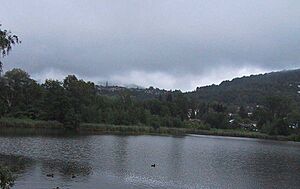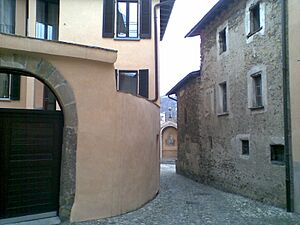Origlio facts for kids
Quick facts for kids
Origlio
|
||
|---|---|---|

Origlio village
|
||
|
||
| Country | Switzerland | |
| Canton | Ticino | |
| District | Lugano | |
| Area | ||
| • Total | 2.08 km2 (0.80 sq mi) | |
| Elevation | 452 m (1,483 ft) | |
| Population
(Dec 2020 )
|
||
| • Total | 1,497 | |
| • Density | 719.7/km2 (1,864/sq mi) | |
| Postal code |
6945
|
|
| Surrounded by | Capriasca, Comano, Cureglia, Lamone, Ponte Capriasca, Torricella-Taverne | |
Origlio is a small town, also called a municipality, in the Lugano area of Ticino canton in Switzerland. It's a lovely place with a rich history and beautiful natural surroundings.
Contents
A Look at Origlio's Past
Origlio was first mentioned in official records way back in 1335. It was called Orellio then.
Life in the Middle Ages
During the Middle Ages (a long time ago, from about 500 to 1500 AD), Origlio was part of the larger Lugano valley community. Sadly, in 1484, a terrible sickness called the plague swept through the village.
In the 1400s, Origlio was controlled by the Duke of Milan. The villagers had to provide soldiers and weapons to him. Later, under the Swiss Confederation (a group of states that formed Switzerland), Origlio became part of the Lugano region. In 1803, it officially joined the Lugano district.
Churches and Their Stories
The very first church in Origlio was built in the 8th century. The church of San Vittore Mauro in Carnago stands where this old church once was. In 1570, it became a main parish church, serving the local community.
After 1812, another church, SS Giorgio and Maria Immacolata, also shared duties. This church was built in the 1600s. Inside, you can see beautiful wall paintings called frescoes and fancy decorations made of plaster, known as stucco work.
How Origlio Grew
For a long time, the village's economy depended on growing grapes for wine (called viticulture), raising silkworms, and farming. In the 1950s, Origlio started to become a popular place to live and visit. This led to a big increase in people moving there. By the 1980s, the population had doubled!
Exploring Origlio's Geography
Origlio covers an area of about 2.07 square kilometers (about 0.8 square miles). A big part of this land, about 60%, is covered by forests. Around 27% is used for farming. The rest of the land has buildings, roads, or is covered by rivers and lakes.
The town is located in a valley that was shaped by glaciers long ago. It's also very close to Lago di Origlio, a beautiful lake. Origlio includes the main village and a smaller area called Carnago.
Who Lives in Origlio?
Origlio has a population of about 1,366 people. Around 15% of the people living here are from other countries. Over the last ten years, the population has grown by about 14.5%.
Languages Spoken
Most people in Origlio, about 81%, speak Italian. This is the main language in the Ticino canton. About 13% of the people speak German, and a smaller number, about 2%, speak French.
Age Groups in Origlio
In Origlio, about 10% of the population are children under 10 years old. Teenagers, aged 10 to 19, make up about 16% of the population. Adults between 20 and 59 make up a large part of the community. Older adults, aged 60 and above, make up about 20% of the population.
Homes and Families
There are about 462 homes in Origlio, with an average of 2.5 people living in each. Most of the buildings, about 76%, are single-family homes. There are also some two-family and multi-family buildings. Most of the apartments in Origlio are lived in all year round.
The historical population is shown in the chart below:

Important Sights in Origlio
The entire village of Origlio is recognized as part of the Inventory of Swiss Heritage Sites. This means it has special historical and cultural importance, and its buildings and landscape are protected.
Origlio's Economy and Work Life
In Origlio, people work in different types of jobs.
Types of Jobs
- Primary sector: A small number of people work in farming.
- Secondary sector: Some people work in manufacturing or construction.
- Tertiary sector: Most people work in services, like shops, offices, or tourism.
In 2007, the unemployment rate was low, at about 2.61%. This means most people who wanted to work had jobs.
Commuting and Travel
Many people who live in Origlio travel to other towns for work. About 70% of workers use a private car to get to their jobs, while a smaller number use public transportation.
Tourism
Origlio also has a few hotels, showing that it's a place where visitors come to stay.
Religion in Origlio
Based on a census from 2000, most people in Origlio, about 71%, are Roman Catholic. About 12% belong to the Swiss Reformed Church. A small number of people belong to other churches or did not state their religion.
Education in Origlio
Origlio has a good education system. About 84% of adults (aged 25 to 64) have completed high school or gone on to higher education, like university or a specialized college (called a Fachhochschule).
School System
In 2009, there were 286 students in Origlio. The Ticino education system offers:
- Kindergarten: Up to three years of non-mandatory kindergarten. In Origlio, 36 children were in kindergarten.
- Primary School: This program lasts for five years. There were 77 students in standard primary schools.
- Lower Secondary School: Students can choose between a two-year middle school followed by a two-year pre-apprenticeship, or a four-year program to prepare for higher education.
- Upper Secondary School: This prepares students for a trade or for university. Students can attend school while doing an internship or apprenticeship.
- Professional Program: This three-year program prepares students for jobs in fields like engineering, nursing, or business.
Many students from Origlio attend schools in other towns, and students from other towns also come to school in Origlio.
See also
 In Spanish: Origlio para niños
In Spanish: Origlio para niños






